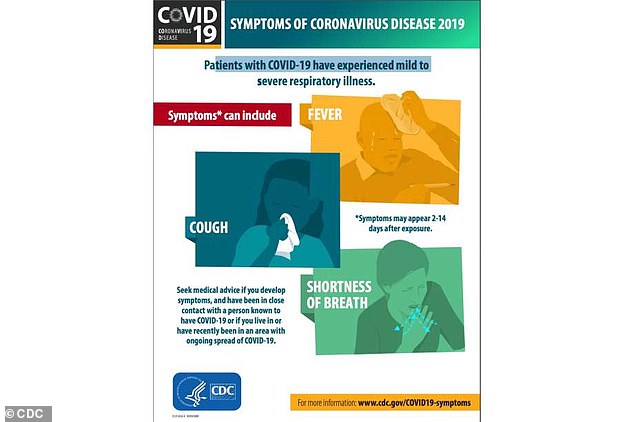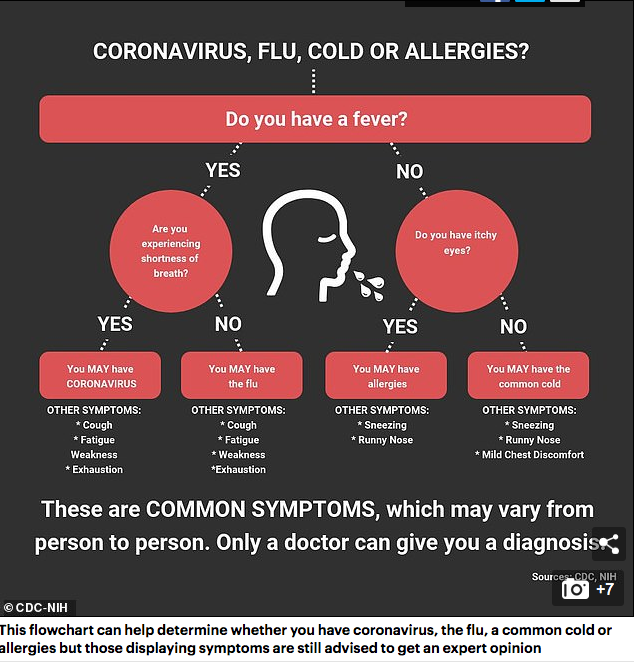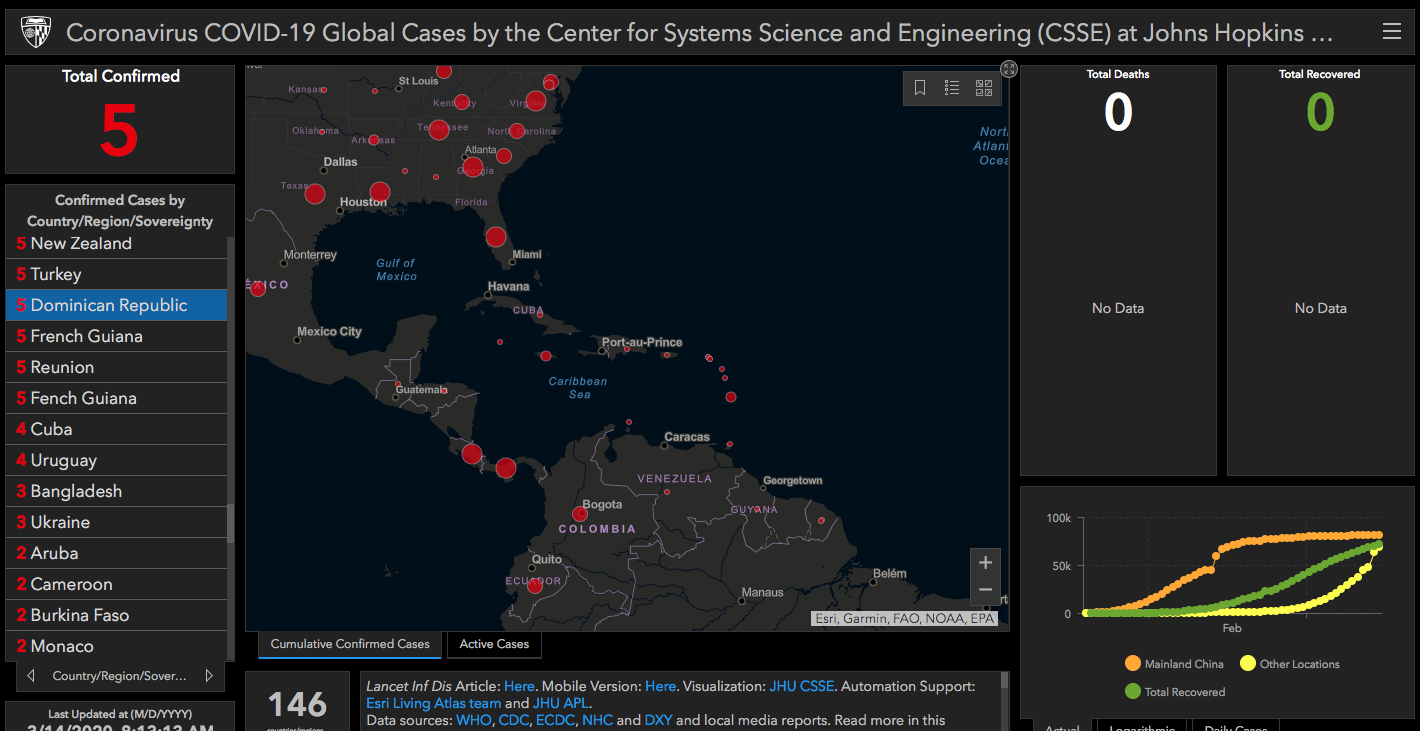
- A fever, a cough and shortness of breath can help you identify whether you have the coronavirus, the flu, a common cold, or allergies
- A flow chart graphic lists symptoms to help identify which you have
- If you don’t have a fever, it’s more likely you have a cold or allergies
- Other coronavirus symptoms include fatigue and difficulty breathing
- Symptoms vary from patient to patient
- It can take between two and 14 days for symptoms to manifest after exposure
- A correct diagnosis can only be given by a medical professional
- Coronavirus symptoms: what are they and should you see a doctor?
By Frances Mulraney For Dailymail.com
A fever, a cough and shortness of breath have been identified as crucial symptoms that suggest you may have contracted the coronavirus, according to a graphic released by the Center for Disease Control.
The coronavirus, which as of midnight had infected more than 2,200 people and caused 50 deaths in the United States, manifests itself with symptoms that are very similar to the common cold, the flu or allergies but a fever and shortness of breath in particular are believed to be tell-tale signs that you have COVID-19.

A flow chart created using information from the U.S. Centers for Disease Control and Prevention and the National Institute of Health breaks down the symptoms which are most common when suffering from the coronavirus, the flu, a cold or allergies to help identify which you may have.
By answering yes or no to whether or not you have a fever, you can rule out the coronavirus, which it list as one of its main symptoms.
If you do have a fever, the flow chart than asks if you have shortness of breath. If yes, you may have the coronavirus, if not, you may have the flu.
Other symptoms of the virus are listed as a cough, fatigue, weakness and exhaustion.
These are also the symptoms of the flu, leaving medical professionals urging those who fear they may have the coronavirus to seek an expert opinion.
Patients who contract the virus are said to experience mild to severe respiratory illness and symptoms can take anywhere between two and 14 days after exposure to appear.

Symptoms may also vary from person to person meaning that only a doctor can give you a correct diagnosis.
Those who believe they are showing these symptoms are recommended to seek medical advice.
‘From a clinical perspective, I don’t think it is possible to distinguish Covid-19 from influenza or some other respiratory pathogens,’ John Swartzberg, a clinical professor at UC Berkeley’s Infectious Disease and Vaccinology Division, told the San Francisco Gate.
‘Shortness of breath can occur with any of these, granted, Covid is more likely to do this. The only way to make a diagnosis is to have a test. If you have influenza, there is a good and fairly quick test for this, and there is a medication to take.’
‘The reason is influenza is a treatable disease with Tamiflu,’ added Dr. George Rutherford, an epidemiologist and director of UCSF’s Prevention and Public Health Group.
‘They can do a nasal swab on the spot and they can treat you right on the spot.’
In a separate graphic, the CDC revealed some of the best practices to use to ensure you’re not spreading germs linked to respiratory diseases such as COVID-19.
The CDC advises that people avoid close contact with people who are sick, cover a cough or a sneeze with a tissue, clean and disinfect frequently touched objects or surfaces, avoid touching your face, and clean your hands with soap and warm water for at least 20 seconds.
Most importantly they advise to remain at home when sick except to get medical attention.


HOW DANGEROUS IS CORONAVIRUS?
About 14 per cent of people who contract the Covid-19 coronavirus are taken to hospital – with severe symptoms including breathing problems and pneumonia. About 5 per cent need intensive care.
But the majority who get the virus suffer nothing more than a cough and may never know they are infected. So far, some 51,000 people around the world have already recovered from coronavirus – and that just includes the numbers who received a diagnosis.
HOW MANY PEOPLE DIE?
Officially, the death rate so far has been just over 3 per cent. But experts believe the true mortality rate is probably between 1 and 2 per cent. This is because most mild cases have not been picked up by doctors or reflected in the official numbers – so the death rate is inflated.
Seasonal flu kills roughly 0.1 per cent of people. So Covid-19 is between 10 and 20 times more fatal. But it is far less dangerous than SARS – the virus that ripped across China in 2003 – which killed 10 per cent of patients.

Those displaying symptoms such as fever and a cough are advised to self-isolate

The CDC advises to clean your hands with soap and warm water for at least 20 seconds.
CAN IT BE SPREAD WITHOUT SYMPTOMS?
Initially scientists feared carriers who had no symptoms could pass it on. That is now in doubt. What is likely, however, is those who have mild symptoms are putting it down to a cold and going about their normal lives – which puts others at risk.
HOW LONG IS IT BEFORE SYMPTOMS APPEAR?
Again, unclear. Initially scientists said this could take up to two weeks. But recent evidence suggests the incubation period could be as long as a month – particularly among children. The average, however, is much shorter. A Chinese study said the average period of symptom onset was 5.4 days for adults and 6.5 for children.
